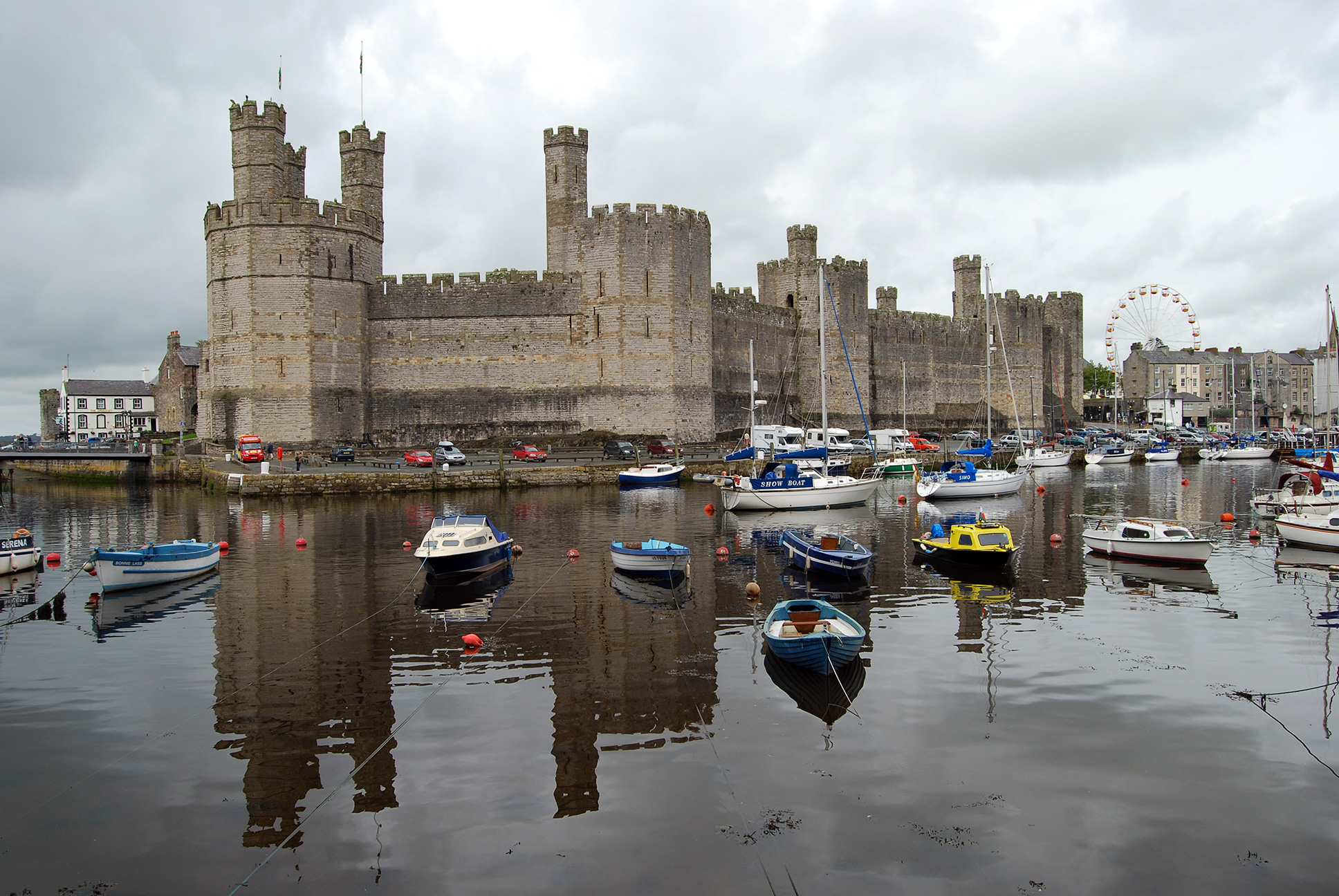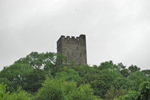History
Caernarfon Castle is situated on the River Seiont and the southern end of the Menai Strait. The site served as a strategic location in northwest Wales before the construction of the castle in approximately 1090 by the Earl of Chester, Hugh D'Avranches, for the Roman fort of Segontium, built centuries before, resides nearby. The castle, one of the most impressive in Wales, featured traditional Norman motte and bailey style architecture with earthen banks and wooden palisade walls.

In 1283, during the Second War of Welsh Independence, King Edward I of England began constructing the current Caernarfon Castle and nearby Conwy Castle and Harlech Castle to control Northern Wales. The motte of the Norman style castle was incorporated into the Edwardian Castle that constitutes the upper ward of Caernarfon Castle today. Due to its location along the River Seiont, building materials and stone could be easily transported by boat to the construction site. The architectural design and construction of Caernarfon Castle were handled by the king's master mason, James of Saint George, who worked on other castles in Wales. Foundations for the towers began, and stone curtain walls rose to 12 meters.
In 1294, a Welsh rebellion led by Madog ap Llywelyn attacked the castle and town of Caernarfon, overrunning defenders and setting fire to everything combustible within the castle. However, the English regained control of the castle and town by the following summer and rebuilt the defenses by November 1295. Thereafter, repairs to the castle and significant construction activities were performed to complete previously unfinished work. According to legend, Edward promised the Welsh population he would name "a prince born in Wales, who did not speak a word of English." To their surprise, an infant son of the king was born in 1284. Later known as Edward of Caernarfon, his son became the Prince of Wales in 1301, thereby fulfilling King Edward's prophecy.
In 1317, the massive Eagle Tower of Caernarfon Castle was nearly complete, with a carved stone eagle affixed to the top of one of the tower turrets. Most construction on the castle, which remains visible today, was completed by 1330. The castle would serve as Edward's administrative center for managing lands grouped in the new shires of Caernarvon. When Henry Tudor came to the English throne in 1485, his Welsh lineage softened pre-existing hostilities between the English and Welsh. As a result, the likelihood of conflict and, consequently, the need for structural defenses were significantly reduced. Thereafter, the great Edwardian castles of Wales began to fall into neglect and ruin. By 1620, the Eagle Tower and the King's Gate remained the only portions of Caernarfon Castle still roofed.
During the English Civil War from 1642 to 1648, the castle was besieged thrice; however, its outer walls remained intact. This was the last time the castle was used in war. In 1660, the government gave the order to dismantle and demolish the castle and the town walls. As the order went unfulfilled, the castle and town walls were never demolished; thus, they still marvel to this day. In 1969, the investiture of Charles, Prince of Wales, occurred at Caernarfon Castle. Prince Charles is the 21st holder of the title, which began in 1301 when Edward I formally created his son Prince of Wales. The title is intended for the male heir apparent to the throne but is an appointment rather than a birthright. In fact, every male heir to the British throne has been given the title since 1301.
Castle Highlights
Unlike other Edwardian castles in Wales, Caernarfon Castle is adorned with multi-angular towers, and broad bands of different colored stone said to resemble one of the best-known monuments of imperial Rome, the city walls of Constantinople. Therefore, it is presumed Edward I planned for Caernarfon Castle to serve as his seat of power in Wales dating back to its construction. The most impressive part of the castle is its massive Eagle Tower, which contains five apartments on each of the three floors above the basement chamber. The roof of the Eagle Tower includes three smaller turrets. A multimedia exhibit within the Eagle Tower provides an informative presentation regarding the castle's history.
The King's Gate serves as the current entrance to Caernarfon Castle. If original construction plans had been completed as intended, the structure would have included a drawbridge, five wooden doors, six portcullises, and an array of murder holes and arrow slits. The Granary Tower contains multiple groupings of arrow slits that enable an archer to defend three sides of the tower from a single location. The angles of the walls and slits on the interior gave a maximum range for shooting while protecting archers from enemy crossfire outside the castle.
The Royal Welsh Fusiliers Museum is also housed in two of the towers of Caernarfon Castle, providing a wealth of exhibits telling the story of over 300 years of service by Wales' oldest infantry regiment.
I recommend visiting Caernarfon Castle during high tide and walking across the bridge spanning the River Seiont. The views of the castle with its walls reflecting in the river are spectacular. While still a nice view at low tide, reflections of a muddy riverbed will be seen instead. Visiting Caernarfon Castle should only take a part of the day unless you include the walled town. Conwy Castle is close to the east and makes a good companion visit on the same day.
Caernarfon Castle is also haunted.




